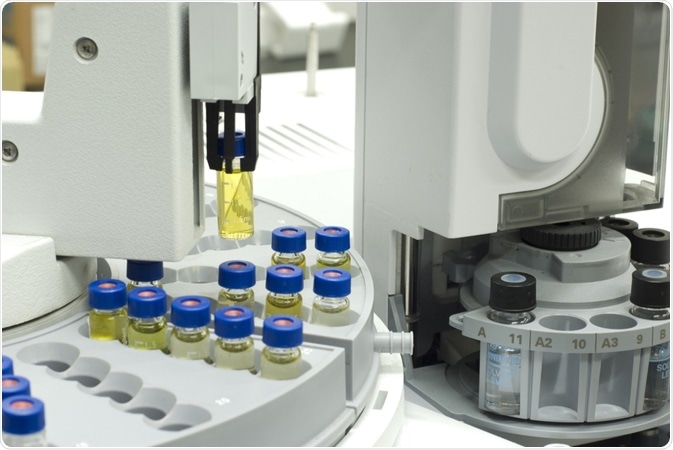Gas chromatography was discovered by Russian-Italian botanist, Mikhail Semyonovich Tsvet, in the early 1900s. The separation technique is used to first split the chemical components of a mixture, then determine the presence or absence of each component as well as to measure the level of each detected component.

Image Credit: Yenyu Shih/Shutterstock.com
Gas chromatography is usually used to separate and measure organic molecules and gases. For the technique to function, the components being analyzed must be volatile, be thermally stable, and have a molecular weight of below 1250 Da.
Since its discovery at the turn of the previous century, gas chromatography has been adopted by a wide number of industries and is now used for an increasingly growing list of applications. Below, we discuss the most common applications of gas chromatography.
Food analysis
The food industry relies on the technique of gas chromatography for several applications, including the quantitative and qualitative analysis of food, the analysis of food additives, components of flavor and aroma, and the detection and analysis of contaminants such as environmental pollutants, pesticides, fumigants, and naturally occurring toxins.
Gas chromatography is vital to the food industry for ensuring the safety of food products, preventing contaminated products from becoming available for consumption. The technique is also essential to ensuring the quality of food products, ensuring that the flavor and taste, texture, and smell remain consistent. While other techniques are implemented by the food industry, gas chromatography remains a highly favored method due to its ease of use and cost-effectiveness.
Quality control
Manufacturing relies on gas chromatography for quality control, companies that produce cars, chemicals, and pharmaceuticals, in particular, are big adopters of the technology.
The pharmaceutical industry uses gas chromatography to help produce pure products in large quantities. The method is used to ensure the purity of the produced material, eliminated inconsistencies in pharmaceutical products. The industry also uses gas chromatography to analyze compounds to check for trace contaminants. Currently, there is also a growing use of the method within the pharmaceutical industry to separate chiral compounds.
Studies have shown that the interiors of new automobiles release a significant amount of volatile organic compounds (VOCs). For this reason, gas chromatography has been adopted by the automotive industry to identify and measure the chemicals that are released into the air inside the car from its carpets, door linings, pedals, seat covers, and other interior materials. Scientists aim to reduce the levels of harmful toxins released into the interiors of new vehicles.
Producers of chemicals also heavily rely on gas chromatography, particularly when making emulsifiers, solvents, and co-solvents, to ensure that they maintain the same quality when production is scaled up.
Research
Gas chromatography is fundamental to many research areas, in particular, for the analysis of meteorites and natural products. Scientists use gas chromatography to analyze the composition of meteorites that fall to the earth.
This provides vitally important information regarding the nature of life outside of earth, as well as revealing details about primitive life on earth. Specifically, many studies have been conducted with gas chromatography to determine the presence of ribose in meteorites, the building block of RNA.
Forensics
For many years gas chromatography has been used in forensic science. Mostly, it is used to determine the circumstances of a person’s death, such as whether they ingested poison, or consumed drugs or alcohol in the hours prior. Scientists take samples of blood and fibers from the crime scene and analyze them using gas chromatography to help investigators piece together the facts.
Measuring air pollution
Air pollution has become an increasing problem in recent decades. Rapid urbanization has lead to more people living in cities where they are exposed to the pollutants expelled by vehicles and industry. Also, there is a growing body of evidence that has implicated air pollution as a risk factor in developing numerous diseases, such as cancer.
Gas chromatography is being used to combat the problem, by monitoring the levels of harmful pollutants in the air so that scientists can visualize where air pollution is more concentrated, and how this changes throughout the day and the year to develop effective preventative methods.

Image Credit: VanderWolf Images/Shutterstock.com
Blood alcohol analysis
Gas chromatography has been used since the 1950s to detect blood alcohol levels. Since then, it has continued to be used to detect how much alcohol a person has consumed to help gauge how impaired their normal functioning may be. Also, it has been adopted by forensic science to determine blood alcohol levels at the time of death.
Summary
To date, there are a wide number of applications of gas chromatography. Its benefits, such as its high sensitivity and relatively cheap operating cost has made it appealing to many industries needed to detect and measure compounds and molecules within a sample. The method will likely continue to be a key technique used across sectors.
Sources:
- Grabbs, J., Corsi, R., and Torres, V., 2000. Volatile Organic Compounds in New Automobiles: Screening Assessment. Journal of Environmental Engineering, 126(10), pp.974-977. www.researchgate.net/…/259913148_Volatile_Organic_Compounds_in_New_Automobiles_Screening_Assessment
- Furukawa, Y., Chikaraishi, Y., Ohkouchi, N., Ogawa, N., Glavin, D., Dworkin, J., Abe, C., and Nakamura, T., 2019. Extraterrestrial ribose and other sugars in primitive meteorites. Proceedings of the National Academy of Sciences, 116(49), pp.24440-24445. https://www.pnas.org/content/116/49/24440
- Rohn, S., 2014. Gas Chromatography in Food Analysis. Practical Gas Chromatography, pp.745-766. https://link.springer.com/chapter/10.1007/978-3-642-54640-2_21
- Lehotay, S., and Hajšlová, J., 2002. Application of gas chromatography in food analysis. TrAC Trends in Analytical Chemistry, 21(9-10), pp.686-697. www.sciencedirect.com/science/article/abs/pii/S0165993602008051
- Vetter, W., 2015. Current Use of Gas Chromatography and Applications. Analytical Separation Science, pp.849-882. https://onlinelibrary.wiley.com/doi/abs/10.1002/9783527678129.assep026
Further Reading
- All Chromatography Content
- Chromatography Overview
- Gas Chromatography-Mass Spectrometry (GC-MS) Applications
- High Performance Liquid Chromatography (HPLC)
- Liquid Chromatography-Mass Spectrometry (LC-MS) Applications
Last Updated: Oct 22, 2020

Written by
Sarah Moore
After studying Psychology and then Neuroscience, Sarah quickly found her enjoyment for researching and writing research papers; turning to a passion to connect ideas with people through writing.
Source: Read Full Article


